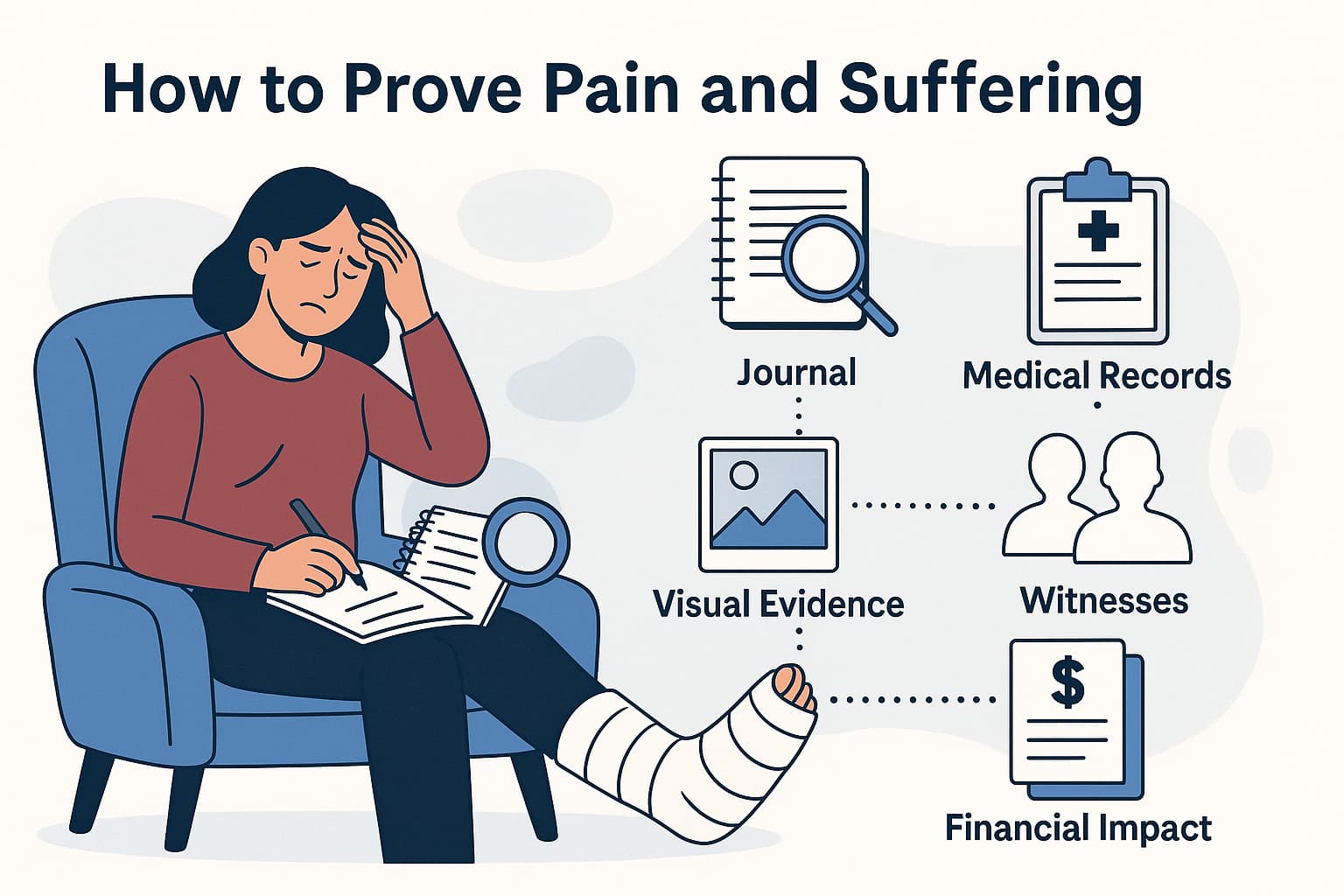The world sees a bandage or a limp, but it doesn’t know the ache that wakes you at night. It doesn’t feel the frustration of being unable to do simple tasks. If an injury has turned your life upside down, you’re likely asking, How can I prove my pain and suffering?
You demonstrate your pain and suffering by consistently recording your experiences and gathering different types of information that show the complete picture of your life after the injury. To strengthen your case and make sure your voice is heard, consider speaking with a personal injury lawyer who can guide you through every step.
Schedule a free case evaluation
How To Prove Pain and Suffering in a Personal Injury Claim
When you file a claim for an injury due to someone else’s negligence, pain and suffering refers to the non-physical and physical hardships you face. It’s a term that covers a wide range of impacts. Showing your pain and suffering is about illustrating how the injury has truly affected your day-to-day existence.
This includes the actual physical pain you feel, like aches, throbbing, or sharp pains. It also includes emotional distress, such as anxiety, sadness, fear, or sleeplessness, caused by the injury. Another part is the loss of enjoyment of life, meaning you can’t do hobbies or activities you once loved.
Starting Your Record: The Value of a Personal Journal
Keeping a personal journal is a powerful way to document your daily experiences. It creates a consistent record of how your injury affects you over time.
What To Include in Your Pain and Suffering Journal
A thorough journal helps others understand the scope of your pain, so include details that paint a clear picture of your daily life.
Think about these areas:
- Daily Pain Levels: Rate your pain on a scale of 1 to 10 and describe how it feels (e.g., burning, stabbing, aching).
- Activities Affected: Note tasks you found difficult, needed help with, or couldn’t do at all, from personal care to household chores or work duties.
- Emotional Impact: Record your feelings, such as moments of frustration, sadness, irritability, or anxiety related to your pain and limitations.
Tips for Keeping an Effective Journal
To make your journal a useful tool for explaining your pain, write entries regularly (daily if possible) while memories are fresh. Be honest and specific in your descriptions; avoid exaggerating and minimizing what you endure.
Note particular examples of how pain stopped you from doing something, rather than just saying you felt bad. This kind of detailed record can be beneficial to show your day-to-day struggles when filing a personal injury claim.
Gathering Medical Evidence
Your medical records provide an important foundation for demonstrating your pain and suffering. You must continue to communicate clearly and openly with your doctors and other healthcare providers. Their notes create an official account of your injuries and recovery process.
Tell your doctor about your pain at every visit. Describe its location, intensity, and what makes it better or worse. Explain how the pain and any physical limitations affect your daily activities, your mood, and your sleep.
Ask your healthcare providers to make detailed notes about what you report concerning your pain and limitations. Information in your medical files can support your statements about your suffering.
Beyond Doctor Visits: Other Medical Proof
Records from physical therapy sessions show your efforts to recover and the challenges you face. If you see a therapist or counselor for emotional distress stemming from your injury, those records also become part of the evidence of your suffering.
Using Witness Accounts to Demonstrate Your Pain and Suffering
People who know you well often see firsthand how an injury has changed your life. Their observations offer an outside perspective on your pain and suffering. These accounts help confirm that your struggles are real and have a noticeable impact.
Who Makes a Good Witness for Your Pain and Suffering?
Certain people are in a good position to discuss the changes they’ve seen in you. People who see you often and knew you before the injury are invaluable. Their testimony can help establish how your pain and suffering have altered your daily life.
Examples include:
- Family Members: Your family members, especially the ones who live with you, observe your daily struggles, mood changes, and difficulties with personal tasks.
- Close Friends: Friends who interact with you regularly likely notice differences in activity levels, social engagement, and overall happiness.
- Coworkers or Supervisors: If your injury affects your job, colleagues probably can see how your pain impacts your ability to perform work duties.
Witnesses can describe specific changes they’ve noticed since your injury. They might talk about activities you used to enjoy but no longer do, or explain differences in your mood or how you interact with others.
Witnesses may have seen you struggle with physical tasks that were once easy for you. Their combined stories create a fuller image of your life post-injury.
How You Can Prove Pain and Suffering With Visual Evidence
Sometimes, seeing is understanding. Photographs and videos create a visual record of your injuries and their impact. This kind of evidence makes your challenges more concrete for others.
Visuals show aspects of your suffering that words alone might not fully convey. You can document the progression of visible injuries like bruises, swelling, or scars with dated photos.
If you’re comfortable and it can be done naturally, a video might show your difficulty with a common daily task, illustrating your physical limitations. Also, photos of any modifications to your home, like a ramp or bathroom grab bars, demonstrate the long-term effects of your injury.
Schedule a free case evaluation
Showing the Financial and Lifestyle Impact of Your Suffering
Pain and suffering don’t just affect your body and emotions; they often have financial and lifestyle consequences. Documenting these aspects helps to complete the picture of how the injury has impacted your entire life. It’s another way to show your suffering in tangible terms.
Your injury might prevent you from doing things you once loved. List hobbies, sports, or social activities you’ve had to give up or significantly reduce. Note any family events, vacations, or special occasions you missed due to injury or pain.
This demonstrates how your quality of life has diminished, a key piece in how you can prove pain and suffering.
Tracking Financial Effects
Keep careful records if your pain and suffering causes related financial costs. If your injuries prevent you from working, track your lost wages. If you now must pay for help with childcare or household chores you used to manage yourself, save those receipts.
How a Lawyer Helps With Proving Pain and Suffering
You’ve learned about different ways to document your experiences and collect evidence. Now, consider how a legal professional assists you in proving your pain and suffering. A personal injury attorney offers guidance and uses their knowledge to build a strong presentation of your claim.
They become your advocate, keeping your questions, concerns, and case details private.
They Know What Evidence Is Persuasive
Lawyers who handle injury claims know what types of proof effectively communicate pain and suffering to insurance companies and, if necessary, to a court.
They guide you on the kinds of documentation that are most useful for your specific situation in West Virginia. They can gather meaningful evidence for you to build your case.
Building a Comprehensive Picture of Your Pain and Suffering
A lawyer does more than just collect papers. They weave together your personal journal, medical records, witness statements, and any visual or financial proof into a coherent and compelling narrative.
They ensure that all the pieces work together to show the full extent of your pain and suffering. This organized approach presents your experience in a way that is easy to understand and hard to refute.
Handling Insurance Companies
Interacting with insurance adjusters can be stressful, especially since they might try to get you to accept an offer that doesn’t include compensation for pain and suffering. Lawyers take on this burden for you, handling all interactions with insurers.
They know how to talk to adjusters and protect you from tactics that might try to minimize your pain and suffering claim. They advocate for a fair assessment of what you have endured.
Connecting With Other Professionals
In some cases, statements from other professionals bolster your claim for pain and suffering. Your lawyer identifies if opinions from medical evaluators or vocational rehabilitation assessors might add value.
They then manage the process of obtaining these additional supporting documents to strengthen your case for the pain and suffering you’ve experienced.
Fighting for Fair Compensation
Your lawyer uses the evidence of your pain and suffering to negotiate with the other side for a fair settlement. If the insurance company or responsible party doesn’t offer a just amount, your lawyer can take your case to court.
They’ll present your story and the proof of your suffering to a judge to seek the compensation you deserve.
FAQ for How Can I Prove My Pain and Suffering?
What Is the Best Way To Start Documenting My Pain and Suffering?
The best way to begin is by starting a detailed daily journal immediately after your injury. In this journal, record your physical sensations, noting the type and intensity of your pain.
Also, describe your emotional state, any limitations in your daily activities, and how the injury impacts your regular routine. Consistent, timely notes create a strong and credible record of your ongoing experience.
How Do Insurance Companies Typically Evaluate Pain and Suffering Claims?
Insurance companies often look at several factors when they evaluate pain and suffering, including the severity and type of your injuries and the total amount of your medical bills. They also review the length of your recovery period.
The documentation you provide (medical records, pain journal, and statements from people who know you) helps them assess the impact on your life and understand your claim for pain and suffering.
Can My Statements to Doctors About Pain Be Used as Proof?
Yes, your statements to doctors and other healthcare providers about your pain are instrumental when trying to prove your pain and suffering. When you describe your pain, its severity, its location, and how it limits you, your doctors should record this in your medical files.
These medical records become official documentation and are key to showing your continued pain and suffering over time.
How Can I Prove My Pain and Suffering If My Injuries Aren’t Very Visible?
Proving your pain and suffering for injuries that aren’t easily seen, like chronic pain conditions or emotional distress, relies heavily on consistent self-reporting and other forms of evidence. Keeping a detailed pain journal is vital in this scenario.
Testimony from friends, family, or coworkers about changes they observe in your behavior, abilities, or mood also helps. If you’re receiving mental health support, reports from your therapist or counselor help show the reality of your internal suffering.
Does West Virginia Law Allow Award Money for Pain and Suffering?
Yes, West Virginia law allows award money for pain and suffering in personal injury cases. This type of compensation is known as non-economic damages.
The evidence presented about how an injury has affected the person’s life, including their physical discomfort and emotional distress, is used to decide on a fair amount.
However, you must file your claim on time to receive any compensation. Missing the deadline generally means you lose your right to seek compensation. Speak with a lawyer as soon as possible to protect your right to compensation.
Your Hidden Pains Deserve To Be Acknowledged
The journey to make others understand your pain and suffering is not one you should walk alone. While no amount of money truly erases what you’ve been through, getting fair compensation acknowledges your hardship.
You need advocates who listen carefully and know how to present the truth of your experience clearly and effectively. At Robinette Legal Group, PLLC, we understand the complexities of demonstrating something as personal as pain and suffering.
We’re here to help translate your experience into a compelling case. For a free consultation to discuss how we can help prove your pain and suffering, contact us at (304) 594-1800.
Schedule a free case evaluation
Jeffery Robinette was admitted to practice law in 1991 and is licensed in all levels of state and federal trial courts in West Virginia. Mr. Robinette is also licensed in all state and federal appeals courts in West Virginia and the United States Supreme Court. As a National Board Certified Trial Attorney who has handled hundreds of motor vehicle, injury, and construction defect claims and a leading author on insurance claims settlement issues and difficulties in West Virginia, Jeff Robinette is uniquely qualified to represent your best interest.





